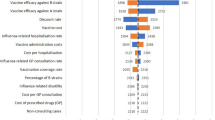Summary
With increasing expenditures in healthcare, in absolute terms as well as in relative terms, interest in the efficiency of certain interventions in healthcare has also increased. Faced with the limitations of the healthcare budget, budget holders try to find the optimal way of dividing their funds over different healthcare provisions, without discarding human and medical considerations. In economic terms, this process could be called the ‘optimal allocation of scarce resources over the inputs of a function of production’. The means of production would then be ‘the provision of healthcare’, whereas the output would be ‘improvement of health’.
Clearly, choices have to be made with regard to spending the healthcare budget. One of the instruments that can help in making such choices is the economic evaluation. In economic evaluations of vaccinations, different vaccination strategies are defined. The consequences in terms of costs and effects of each strategy are being calculated and compared with a reference strategy, which is often the nonintervention strategy, i.e. ‘no vaccination’. According to the way in which the benefit or the output of vaccination — ‘improvement of health’ — is measured, a distinction is made between various methods of economic evaluation: in a cost-effectiveness analysis, health gains are measured in natural units (e.g. prevented infections, prevented illness days, life-years gained, etc.); in a cost-utility analysis, the quality of the health gains is taken into account (e.g. quality adjusted life-year); and in a cost-benefit analysis, health gains are converted into monetary units.
Costs can be divided into direct and indirect costs. Direct costs are directly related to medical treatments (medication, laboratory tests, consultations, etc.) or to vaccination (e.g. purchasing price of the vaccine, costs for administering the vaccine, treatment of side effects, etc.). Costs indirectly related to treatments and vaccination are mainly costs of lost productivity due to disease morbidity or mortality, and opportunity costs.
In comparison with other vaccine-preventable infections, influenza vaccination for the elderly seems acceptable from an economic point of view (about $US650 per life-year gained, in 1981). Cost-effectiveness ratios of other vaccinations range from about $US720 per life-year gained for universal hepatitis B vaccination to about $US 190000 per life-year gained for universal Haemophilus influenzae type b vaccination. Because of differences in methods, the representation of results, and country-specific parameters, different economic evaluations of the same vaccination strategy may show divergent results. Therefore, until sufficient standardisation of economic evaluations exists, comparisons of the sort we are making here should be interpreted with prudence.
Similar content being viewed by others
References
Koplan JP. The benefits and costs of immunization revisited. Drug Inform J 1988; 22: 379–83
Peter G. Childhood immunizations. N Engl J Med 1992; 327: 1794–1800
World Health Organization, Regional Office for Europe. Immunization and communicable disease control. 44th session. Copenhagen 12-16 Sept; 1994: EUR/RC44/14
Anderson RM, May RM. Vaccination and herd immunity to infectious disease. Nature 1985; 318: 323–9
Cohen J. Bumps on the vaccine road. Science 1994; 265: 1371–3
Centers For Disease Control. A framework for assessing the effectiveness of disease and injury prevention. Morb Mortal Wkly Rep 1992; 41 (RR-3): 1–15
Lapre RM, Rutten FFH. Economics in health care [in Dutch]. Lemma, Utrecht: 1993; 440
Drummond M, Davies K. Economic analysis alongside clinical trials. Revisiting the methodological issues. Int J Technol Assess Health Care 1991; 7: 561–73
De Graeve D, Carrin G. Economic evaluation of drugs, part 1 [in Dutch]. HANU 1993; 5: 210–16
Drummond M, Stoddart G, Torrance G. Methods for the economic evaluation of health care programmes. Oxford: University Press, 1987: 182
Cairns J. Discounting and health benefits: another perspective. Health Econ 1992; 1 (1): 76–80
Detsky AS, Naglie IG. A clinician’s guide to cost–effectiveness analysis. Ann Intern Med 1990; 113: 147–54
Tormans G, Van Damme P, Van Doorslaer E. Cost–effectiveness analysis of hepatitis A prevention in travellers. Vaccine 1992; 10 Suppl. 1: 88–92
Beutels P, Tormans G, Van Doorslaer E, et al. An economic evaluation of routine hepatitis B vaccination in Flanders [inDutch]. Report, University of Antwerp, 1995
Beutels P, Clara R, Tormans G, et al. Costs and benefits of routine varicella vaccination in German children. J Infect Dis. In press
Lemiengre M, Cooreman E, De Graeve D, et al. Haemophilus influenzae type b vaccine: review of the literature and economic evaluation [in Dutch]. HANU 1994; 3: 93–106
Willems JS, Sanders CR. Cost–effectiveness and cost–benefit analysis of vaccines. J Infect Dis 1981; 144: 486–93
Willems JS, Sanders CR, Riddiough MA, et al. Cost effectiveness of vaccination against pneumococcal pneumonia. N Engl J Med 1980; 303: 553–9
McNeil BJ, Pauker SG. Decision analysis for public health: principles and illustrations. Ann Rev Public Health 1984; 5: 135–61
Author information
Authors and Affiliations
Rights and permissions
About this article
Cite this article
Van Damme, P., Beutels, P. Economic Evaluation of Vaccination. Pharmacoeconomics 9 (Suppl 3), 8–15 (1996). https://doi.org/10.2165/00019053-199600093-00005
Published:
Issue Date:
DOI: https://doi.org/10.2165/00019053-199600093-00005



